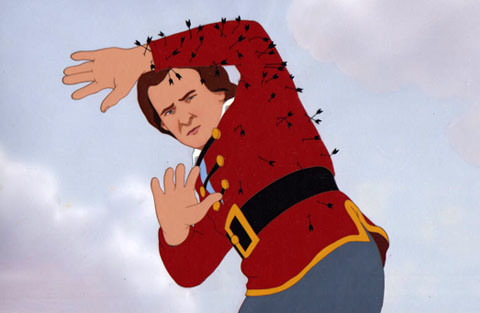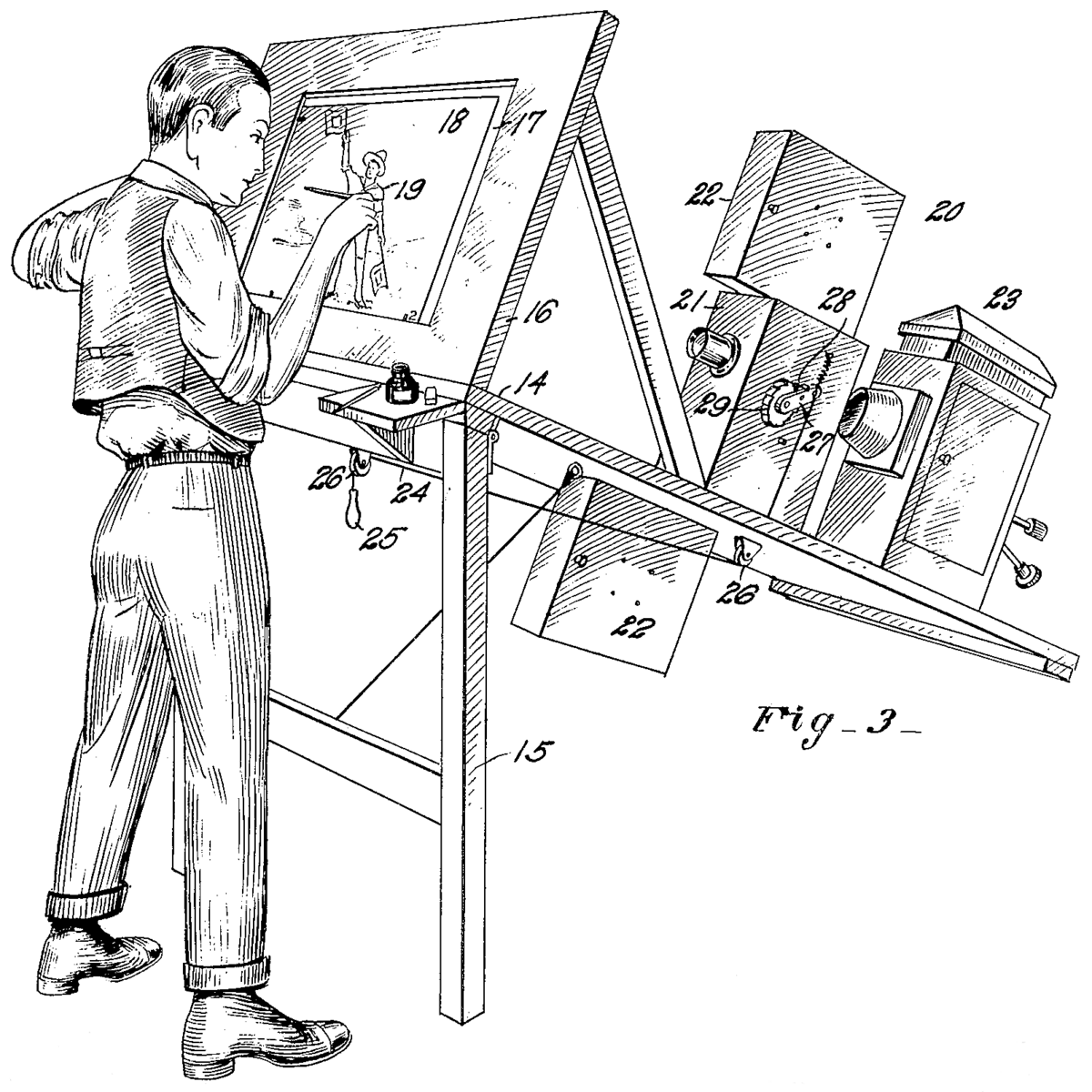Motion Capture is basically just a different name for rotoscoping, a classic animation technique where animators draw over live action footage. Some early examples are:
Snow White and the Seven Dwarfs (1937)
Disney was always very ambitious and strived for realism in his animated cartoons. His foray into the field of Feature Films demanded a new level of realism for the human characters:
You can see how the film became less cartoony over time - the design of the queen being the example used in this documentary:
Early character designs for Snow White and the Seven Dwarfs (1937)
As said in the documentary:
"In the beginning, in 1934, when they started designing these characters, they looked like silly symphonies characters - a lot of them were comic"
"The early designs refined as they grew more used to this (sort of) European, illustrative look for the characters"
"The witch: the whole design is much more geared toward a realistic approach...they were trying to pull out all the stops and convince you these characters were real"
All this is simply to illustrate that Snow White demanded a different kind of approach than what Disney had attempted before. Achieving this in movement was harder than anticipated, the animators weren't used to these realistic depictions and thus rotoscoping was implemented.
(Above) The designs seen in the final film
Before the release of Snow White, Disney studios experimented with many of the techniques used in the final film through the Silly Symphony shorts. Most of which were steps toward creating more realistic depictions of people, animals and the way we see our world. The Old Mill experimented with multi-plane cameras (great little documentary on this technique: https://www.youtube.com/watch?v=YdHTlUGN1zw) and with The Goddess of Spring the studio attempted naturalistic human movement:
To get from here to the animation seen in Snow White, Disney filmed actors in live-action, performing actions that would make their way into the final animated film. The artists used this footage as a guide - basically rotoscoping:
The Alice in Wonderland example is cool because it shows what motion capture would go on to do so well - take a real performance and transform the person into something else completely, even a different animal.
Gulliver's Travels (1939)
Two years after the release, and massive success of Snow White, Fleischer studios released their own feature length animated film. Again they faced the same challenge of bringing a naturalistic human being to life in animation with the title character. The Lilliputians, like the dwarfs, didn't have this issue, as they were exaggerated caricatures.
The rotoscoping here is much more obvious than in Snow White and the Seven Dwarfs, in that film it was hard to tell which character was rotoscoped and when - in Gulliver's Travels the divide is much more apparent:


Cartoon vs Rotoscope
Fleischer is very important to rotoscoping, some would probably call it a crime for mentioning Disney's influence on the technique before talking about Max Fleischer. This is because Fleischer basically invented the technique. Fleischer felt that animation was too stiff and jerky, and along with his brother tested new ways which would allow them to create more fluid and naturalistic animation. This led to a device he patented as the Rotoscope in 1917.

From Wikipedia: Patent drawing for Fleischer's original rotoscope. The artist is drawing on a transparent easel, onto which the movie projector at the right is beaming an image of a single movie frame.
The first rotoscoped cartoon was Out of the Inkwell presents Koko the Clown, which was animated by Fleischer himself.
The video below explores Fleischer's innovation a bit better:
Richard Fleischer, on his father Max: "(He) Really gave cartoons the movement and flexibility we see today"
In the 90's CGI was popularized and suddenly Rotoscoping became much more prevalent, especially in live-action films. Although now it wouldn't be called rotoscoping anymore, instead it became "Motion Capture".
Motion Capture is the same as Rotoscoping in that it uses a real life model as its basis and instead of drawing over it in the traditional sense, the model is replaced with a CGI one.
One of the first examples of this in film is Star Wars: The Phantom Menace, in which George Lucas wanted a fully CGI character in the shape of Jar Jar Binks.
The actor for Jar Jar Ahmed Best said that "I was originally hired just to be the physicality of Jar Jar and then as they were looking for an actor to do the voice over stuff, I'd sent in an audition" - implying that it was originally going to be a similar situation as Darth Vader (where the man in the suit, on set, was not the same man as the voice of the character). It turns out that this became common place down the road for Motion Capture, where actors give a full performance as their characters, later to be replaced with a CGI model that retains all of their acting choices.
Although Star Wars came before, Lord of the Rings was the film that cemented Motion Capture as the next big step forward. The team at Weta created a CGI character that was so fully realized on film that people forgot he wasn't real. That character was of course Gollum.
Back then the performance by Andy Serkis was still used more as a reference, but throughout his career you can see how much the technology has progressed. Compare his performance as Gollum in Lord of the Rings to in The Hobbit. In the latter his performance was captured fully and not as many tweaks had to be made to it from the performance he originally gave to the final product.
The biggest advancement has to be the addition of facial tracking. In the time since the Lord of the Rings the ping-pong ball setup used for recording the actor's movement has evolved to include details in their facial expressions.
This is now called "Performance Capture" - because it isn't just the movement being captured anymore, it's a full performance.
Traditional Rotoscoping is still used today, but more as a stylistic choice rather than an easier way to achieve 2D animation. Examples of this are:Motion Capture is the same as Rotoscoping in that it uses a real life model as its basis and instead of drawing over it in the traditional sense, the model is replaced with a CGI one.
One of the first examples of this in film is Star Wars: The Phantom Menace, in which George Lucas wanted a fully CGI character in the shape of Jar Jar Binks.
The actor for Jar Jar Ahmed Best said that "I was originally hired just to be the physicality of Jar Jar and then as they were looking for an actor to do the voice over stuff, I'd sent in an audition" - implying that it was originally going to be a similar situation as Darth Vader (where the man in the suit, on set, was not the same man as the voice of the character). It turns out that this became common place down the road for Motion Capture, where actors give a full performance as their characters, later to be replaced with a CGI model that retains all of their acting choices.
Although Star Wars came before, Lord of the Rings was the film that cemented Motion Capture as the next big step forward. The team at Weta created a CGI character that was so fully realized on film that people forgot he wasn't real. That character was of course Gollum.
Back then the performance by Andy Serkis was still used more as a reference, but throughout his career you can see how much the technology has progressed. Compare his performance as Gollum in Lord of the Rings to in The Hobbit. In the latter his performance was captured fully and not as many tweaks had to be made to it from the performance he originally gave to the final product.
The biggest advancement has to be the addition of facial tracking. In the time since the Lord of the Rings the ping-pong ball setup used for recording the actor's movement has evolved to include details in their facial expressions.
This is now called "Performance Capture" - because it isn't just the movement being captured anymore, it's a full performance.
Waking Life and A Scanner Darkly


No comments:
Post a Comment